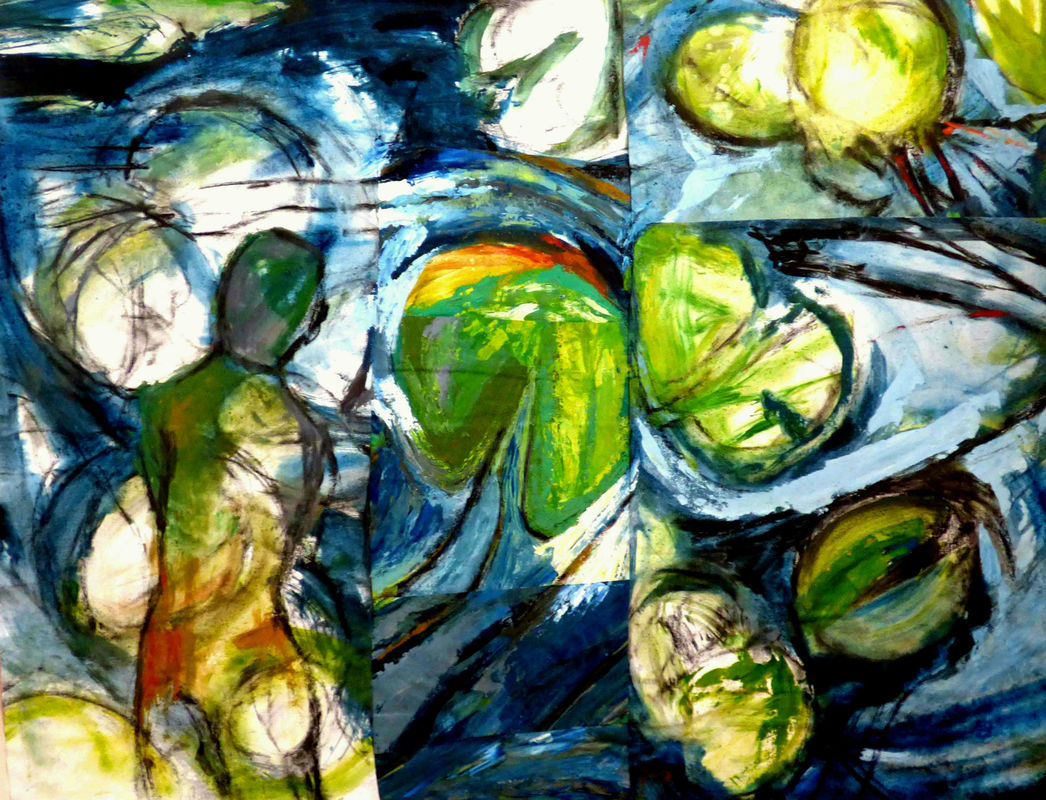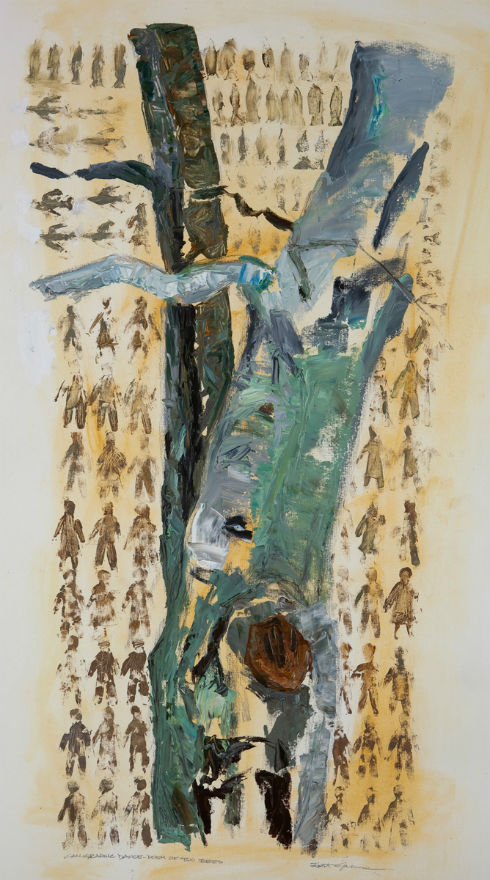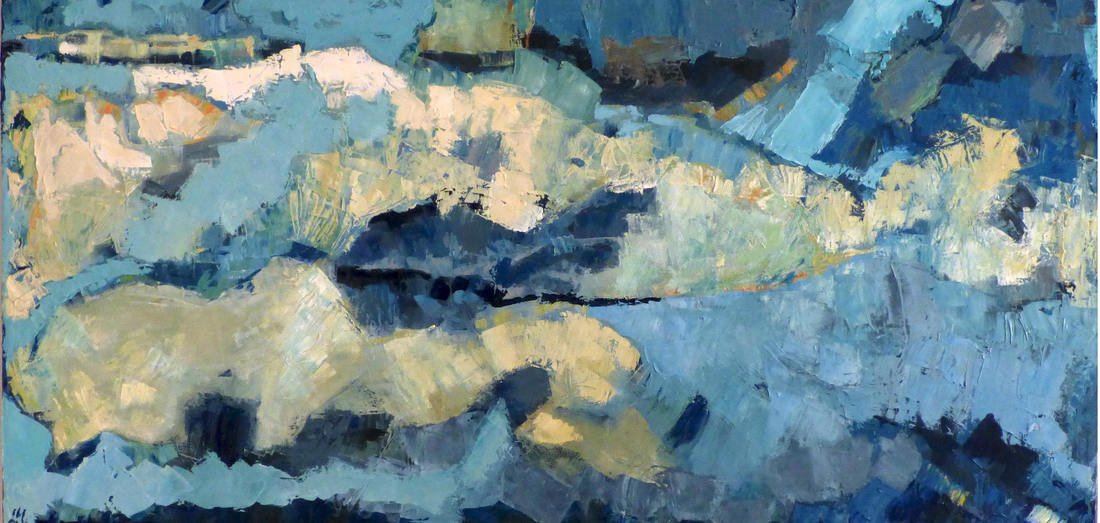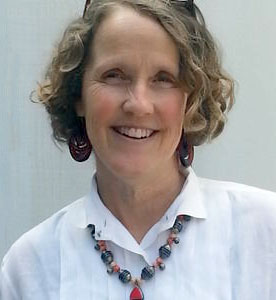Ripples of Our Existence. Oil and Charcoal on Canvas - Collage. Hart James@copyright 2016.

The first time I came to the Pacific Northwest to live, I was driving in my Pinto station wagon with my cat; stopping at Howard Johnson’s for chocolate ice cream cones to share with her; letting her out at rest stops to walk about.
We were driving somewhere in the bleakest part of the route, somewhere between Wyoming and the upper corner of Utah. The color of dust as far as one could see: the dogs, the people, the sagebrush: all the same dusty color.
The terrain had just gotten a little bit more interesting. Some dusty mountains and hills, a few rocks. The road was windy. I realized that I knew what was going to be around the next corner: a wooden mining structure, a building of sorts on stilts leading into the rocky side of the mountain. I drove around the corner to see exactly what I knew to be there. I had dreamed about this very scene before my trip.
The second time I moved to the Pacific Northwest , my son and I were driving through the dusty part of South Dakota. The part that looks like an old Western television show; the old dusty, weather worn wooden buildings with the flat store front architecture; old rusty 1940s cars and car parts lying everywhere in the fields. I looked over and pointed to something in a field. I asked my son, “What’s that?”
His answer was perfect. “A time machine.”
It was a contraption that some industrious, bored, creative (or all of these) South Dakotan had welded together. All the rusty pieces that were lying around the field worked into one monstrosity, one creation. It was identical but slightly smaller than the one I had dreamed about the week before our trip.
I had dreamed that there was an old Western town; pretty much like the ones in the old black and white movies. The dream was in black and white. A giant blimp, or rather a dirigible, was in the sky to the right. It appeared to have a raku-ish finish: all burned greys and molten colors. A tall man with goggles and a long khaki trench coat walked down the middle of the main street of the town and pointed up to the dirigible. It blew up into flames. Then an enormous transformer-like apparatus with all of his parts moving up and down began to slowly inch its way down the streets of the black and white Western town, turning rhythmically at the corners. The thing was made of old rusted machinery parts re-constructed into this THING. The THING in my dream was practically identical to my son’s ‘time machine.’
When I paint I strive to paint using my intuition. Where does the color go? What colors should I use? How will the shapes evolve?
When one paints one is right up on the painting. Whether it be a large painting or a ten inch painting. It is hard to focus on it. Impossible to focus on the whole. I paint with my intuition. Putting a color here. Another stroke over here. One here.
The process becomes rational when I step back from the painting to study it and rationalize it: the composition, the depth, the color, each tiny section…is it working?
I recently was awarded a two week artist’s residency with the Morris Graves Foundation at his “Lake” home in Loleta, California. The president of the Foundation and his wife treated me with the respect that one would give a sage or a religious figure. It was the first time that I have ever had this experience, as ours is a culture that gives artists very little respect or prestige, even among the artists community. Our society asks the artist for their art for free, free for donations, for charitable events, free for the walls of businesses, free classes. Even many large charitable arts organizations designed to ‘support’ the artists ask for their free art for their fund raisers.
The position of artist as sage is an old one, interlaced through our cultures, history, and religions. The sage works from a higher place within.
Alfred Steglitz (Ground breaking photographer, husband of Georgia O’keefe, organizer and supporter of some of the early 1900s American artists): ‘People think that I am only interested in art. That is not true….whether it is scrubbing a floor or painting a picture …only the best work that a man is capable of will finally satisfy him…Only work born of a sacred feeling… and what interests me is whether a man will fight for the opportunity of doing the best work of which he is capable. It seems to me that people will fight for almost anything except that right, and yet nothing else will fulfill in the end.’
Henri Matisse: 'I do not literally paint that table, but the emotion it produces upon me.'
Lisa Fischer, musician, ‘when in that higher space with musicians, it is a higher calling.’
Bob Dylan says of his earlier works, they ’ ….sprung from the waters of the well.’
Art doesn’t come from war or fighting. Intuition is not enriched by war, fighting, or monetary gain. Where does it come from?
The Cave Paintings of Lascaux seem to be possessed with the actual spirit of the animals depicted, possessed with the 'wild.' When viewed by the light of an open flame, as they would have been viewed, the animals seem to move. They have a power, a presence. These are Paleolithic paintings, estimated to be 20,000 years old.
Alexander Pope (1600s-early 1700s) “Essay on Man”: ‘All are but parts of one stupendous whole …that changed through all, and yet in all is the same. Great in the earth ….warms in the sun, refreshes in the breeze, glows in the stars, and blossoms in the trees, lives through all life….all nature is but art.….’
Ralph Waldo Emerson: ‘There can never be deep peace between two spirits, never mutual respect, until in their dialogue each stands for the whole world.’ This is the role of the artist.
Mai Mai Sze, 1963 “The Tao of Painting”: ‘The first canon of painting (the breath of Heaven and Earth, the spirit) stirs all nature to life…and that if a work has ch’I it inevitably reflects a vitality of spirit that is the essence of life itself…through developing them, a painter not only nourishes that part of Heaven in himself but possessing it…creating it…the spiritual aspect becomes a tangible expression.’
Mai Mai Sze “The Tao of Painting”: ‘….unceasing activity of the Tao through the complimentary action of its dual forces (Yin Yang)…the Tao of painting…should describe the ever-changing processes of nature and the Tao. …in observing the way a bud opens into full flower, eventually to shed its place, the painter is exploring an aspect of the Tao…see it at every stage and as a whole…himself….same pattern of movement and change beyond his own limited horizon, on the scale of the whole earth…the whole universe. ….the art of painting is the magic skill or the art of delineating the mysterious.’
Returning to Morris Graves…he painted many paintings with the symbol of a chalice. All his work was autobiographical. The chalice is, as Bob Dylan said, the well of the flow of the waters. The chalice is the vessel holding the heavens. The chalice is our physical body that holds our spiritual powers, that holds our intuition. …and thus we have the artist as the sage.
…in closing, this is not to expect others to get down in praise to artists, but to understand art a little more and, in essence, it is about finding the spirit/the heaven/ the flow of waters from your well. …within yourself. If we all strive to find this place and, in process, respect that place in others, we have indeed made a better world.
We were driving somewhere in the bleakest part of the route, somewhere between Wyoming and the upper corner of Utah. The color of dust as far as one could see: the dogs, the people, the sagebrush: all the same dusty color.
The terrain had just gotten a little bit more interesting. Some dusty mountains and hills, a few rocks. The road was windy. I realized that I knew what was going to be around the next corner: a wooden mining structure, a building of sorts on stilts leading into the rocky side of the mountain. I drove around the corner to see exactly what I knew to be there. I had dreamed about this very scene before my trip.
The second time I moved to the Pacific Northwest , my son and I were driving through the dusty part of South Dakota. The part that looks like an old Western television show; the old dusty, weather worn wooden buildings with the flat store front architecture; old rusty 1940s cars and car parts lying everywhere in the fields. I looked over and pointed to something in a field. I asked my son, “What’s that?”
His answer was perfect. “A time machine.”
It was a contraption that some industrious, bored, creative (or all of these) South Dakotan had welded together. All the rusty pieces that were lying around the field worked into one monstrosity, one creation. It was identical but slightly smaller than the one I had dreamed about the week before our trip.
I had dreamed that there was an old Western town; pretty much like the ones in the old black and white movies. The dream was in black and white. A giant blimp, or rather a dirigible, was in the sky to the right. It appeared to have a raku-ish finish: all burned greys and molten colors. A tall man with goggles and a long khaki trench coat walked down the middle of the main street of the town and pointed up to the dirigible. It blew up into flames. Then an enormous transformer-like apparatus with all of his parts moving up and down began to slowly inch its way down the streets of the black and white Western town, turning rhythmically at the corners. The thing was made of old rusted machinery parts re-constructed into this THING. The THING in my dream was practically identical to my son’s ‘time machine.’
When I paint I strive to paint using my intuition. Where does the color go? What colors should I use? How will the shapes evolve?
When one paints one is right up on the painting. Whether it be a large painting or a ten inch painting. It is hard to focus on it. Impossible to focus on the whole. I paint with my intuition. Putting a color here. Another stroke over here. One here.
The process becomes rational when I step back from the painting to study it and rationalize it: the composition, the depth, the color, each tiny section…is it working?
I recently was awarded a two week artist’s residency with the Morris Graves Foundation at his “Lake” home in Loleta, California. The president of the Foundation and his wife treated me with the respect that one would give a sage or a religious figure. It was the first time that I have ever had this experience, as ours is a culture that gives artists very little respect or prestige, even among the artists community. Our society asks the artist for their art for free, free for donations, for charitable events, free for the walls of businesses, free classes. Even many large charitable arts organizations designed to ‘support’ the artists ask for their free art for their fund raisers.
The position of artist as sage is an old one, interlaced through our cultures, history, and religions. The sage works from a higher place within.
Alfred Steglitz (Ground breaking photographer, husband of Georgia O’keefe, organizer and supporter of some of the early 1900s American artists): ‘People think that I am only interested in art. That is not true….whether it is scrubbing a floor or painting a picture …only the best work that a man is capable of will finally satisfy him…Only work born of a sacred feeling… and what interests me is whether a man will fight for the opportunity of doing the best work of which he is capable. It seems to me that people will fight for almost anything except that right, and yet nothing else will fulfill in the end.’
Henri Matisse: 'I do not literally paint that table, but the emotion it produces upon me.'
Lisa Fischer, musician, ‘when in that higher space with musicians, it is a higher calling.’
Bob Dylan says of his earlier works, they ’ ….sprung from the waters of the well.’
Art doesn’t come from war or fighting. Intuition is not enriched by war, fighting, or monetary gain. Where does it come from?
The Cave Paintings of Lascaux seem to be possessed with the actual spirit of the animals depicted, possessed with the 'wild.' When viewed by the light of an open flame, as they would have been viewed, the animals seem to move. They have a power, a presence. These are Paleolithic paintings, estimated to be 20,000 years old.
Alexander Pope (1600s-early 1700s) “Essay on Man”: ‘All are but parts of one stupendous whole …that changed through all, and yet in all is the same. Great in the earth ….warms in the sun, refreshes in the breeze, glows in the stars, and blossoms in the trees, lives through all life….all nature is but art.….’
Ralph Waldo Emerson: ‘There can never be deep peace between two spirits, never mutual respect, until in their dialogue each stands for the whole world.’ This is the role of the artist.
Mai Mai Sze, 1963 “The Tao of Painting”: ‘The first canon of painting (the breath of Heaven and Earth, the spirit) stirs all nature to life…and that if a work has ch’I it inevitably reflects a vitality of spirit that is the essence of life itself…through developing them, a painter not only nourishes that part of Heaven in himself but possessing it…creating it…the spiritual aspect becomes a tangible expression.’
Mai Mai Sze “The Tao of Painting”: ‘….unceasing activity of the Tao through the complimentary action of its dual forces (Yin Yang)…the Tao of painting…should describe the ever-changing processes of nature and the Tao. …in observing the way a bud opens into full flower, eventually to shed its place, the painter is exploring an aspect of the Tao…see it at every stage and as a whole…himself….same pattern of movement and change beyond his own limited horizon, on the scale of the whole earth…the whole universe. ….the art of painting is the magic skill or the art of delineating the mysterious.’
Returning to Morris Graves…he painted many paintings with the symbol of a chalice. All his work was autobiographical. The chalice is, as Bob Dylan said, the well of the flow of the waters. The chalice is the vessel holding the heavens. The chalice is our physical body that holds our spiritual powers, that holds our intuition. …and thus we have the artist as the sage.
…in closing, this is not to expect others to get down in praise to artists, but to understand art a little more and, in essence, it is about finding the spirit/the heaven/ the flow of waters from your well. …within yourself. If we all strive to find this place and, in process, respect that place in others, we have indeed made a better world.



 RSS Feed
RSS Feed